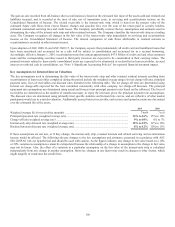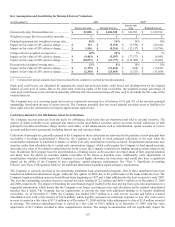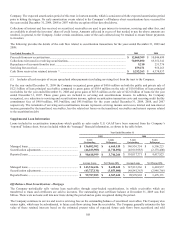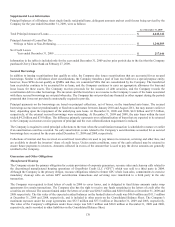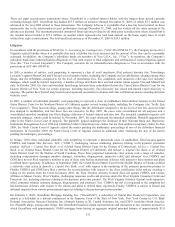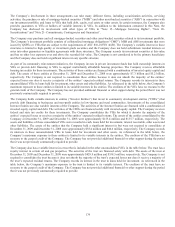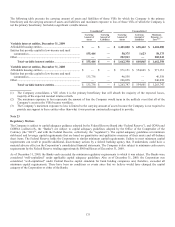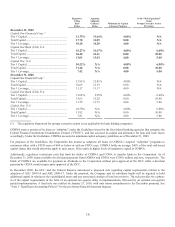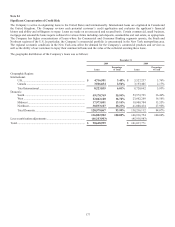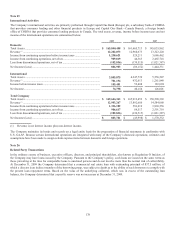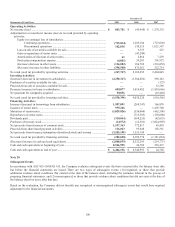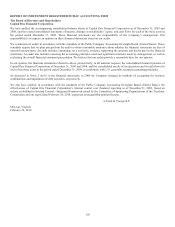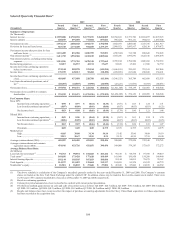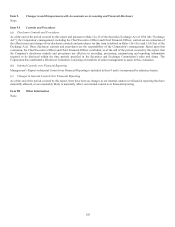Capital One 2009 Annual Report Download - page 189
Download and view the complete annual report
Please find page 189 of the 2009 Capital One annual report below. You can navigate through the pages in the report by either clicking on the pages listed below, or by using the keyword search tool below to find specific information within the annual report.
176
Regulatory
Filing
Basis
Ratios
Applying
Subprime
Guidance
Ratios Minimum for Capital
Adequacy Purposes
To Be “Well Capitalized”
Under
Prompt Corrective Action
Provisions
December 31, 2009
Capital One Financial Corp.(1)
Tier 1 Capital .......................................................
.
13.75% 13.04% 4.00% N/A
Total Capital ........................................................
.
17.70 16.85 8.00 N/A
Tier 1 Leverage ....................................................
.
10.28 10.28 4.00 N/A
Capital One Bank (USA) N.A.
Tier 1 Capital .......................................................
.
18.27% 14.67% 4.00% 6.00%
Total Capital ........................................................
.
26.40 21.41 8.00 10.00
Tier 1 Leverage ....................................................
.
13.03 13.03 4.00 5.00
Capital One, N.A.
Tier 1 Capital .......................................................
.
10.22% N/A 4.00% 6.00%
Total Capital ........................................................
.
11.46 N/A 8.00 10.00
Tier 1 Leverage ....................................................
.
7.42 N/A 4.00 5.00
December 31, 2008
Capital One Financial Corp.(1)
Tier 1 Capital .......................................................
.
13.81% 12.81% 4.00% N/A
Total Capital ........................................................
.
16.65 15.53 8.00 N/A
Tier 1 Leverage ....................................................
.
11.17 11.17 4.00 N/A
Capital One Bank (USA) N.A.
Tier 1 Capital .......................................................
.
13.02% 9.99% 4.00% 6.00%
Total Capital ........................................................
.
15.65 12.26 8.00 10.00
Tier 1 Leverage ....................................................
.
11.79 11.79 4.00 5.00
Capital One, N.A.
Tier 1 Capital .......................................................
.
10.50% N/A 4.00% 6.00%
Total Capital ........................................................
.
11.82 N/A 8.00 10.00
Tier 1 Leverage ....................................................
.
7.81 N/A 4.00 5.00
(1) The regulatory framework for prompt corrective action is not applicable for bank holding companies.
COBNA treats a portion of its loans as “subprime” under the Guidelines issued by the four federal banking agencies that comprise the
Federal Financial Institutions Examination Council (“FFIEC”), and has assessed its capital and allowance for loan and lease losses
accordingly. Under the Guidelines, COBNA exceeds the minimum capital adequacy guidelines as of December 31, 2009.
For purposes of the Guidelines, the Corporation has treated as subprime all loans in COBNA’s targeted “subprime” programs to
customers either with a FICO score of 660 or below or with no FICO score. COBNA holds on average 200% of the total risk-based
capital charge that would otherwise apply to such assets. This results in higher levels of regulatory capital at COBNA.
Additionally, regulatory restrictions exist that limit the ability of COBNA and CONA to transfer funds to the Corporation. As of
December 31, 2009, funds available for dividend payments from COBNA and CONA were $798.0 million and zero, respectively. The
funds of COBNA are available for payment as dividends to the Corporation without prior approval of the OCC while a dividend
payment by CONA would require prior approval of the OCC.
In December 2009, the OCC and the Federal Reserve announced a proposed rule regarding capital requirements related to the
adoption of ASU 2009-16 and ASU 2009-17. Under the proposal, the Company and its subsidiary banks will be required to hold
additional capital in relation to the consolidated assets and any associated creation of loan loss reserves. The rule provides for a phase-
in of the capital requirements in the form of an optional two-quarter delay in implementation, followed by an optional two-quarter
partial implementation. A final rule was ratified on January 21, 2010, with only minor amendments to the December proposal. See
“Note 1- Significant Accounting Policies” for the pro forma financial statement impacts.


